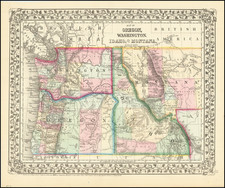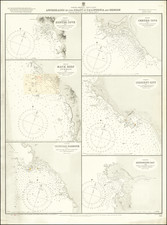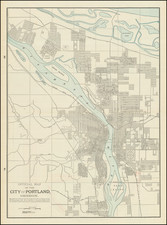Rail Road & Township Map of Oregon, produced by George F. Cram and published in Chicago in 1886, provides an insightful representation of Oregon's rail infrastructure and township organization during the late 19th century. Printed in a contrasting red and black, the map highlights counties, while offering detailed information regarding survey meridians. Notably, the topography of the region is depicted using hachures, a convention of the period, giving readers a tactile sense of Oregon's varied terrain.
The 1880s were a pivotal period for Oregon, marked by significant growth and development. The western expansion and the gold rush had earlier brought a wave of settlers, and by this decade, the establishment of railway networks was fundamental in connecting Oregon's remote and diverse landscapes. Railroads facilitated commerce and communication and played a crucial role in knitting together communities, making places more accessible and contributing to the state's socio-economic progress.
The choice of color in this map, the stark red against a deep black, indicates the emphasis placed on county divisions and their relative significance. During the late 19th century, the delineation of counties and townships in the American West was instrumental in governance, land allotment, and resource management. Such demarcations also informed travelers, businessmen, and settlers about administrative boundaries, aiding navigation and decision-making.
In addition to man-made features, the map's use of hachures to represent topography is of particular note. This method of shading, widely adopted in the 19th century, provides a three-dimensional visualization of the landforms, from the majestic Cascade Range to the undulating valleys. In doing so, it grants viewers an understanding of the region's geographical challenges and beauty, influencing travel, trade routes, and settlement patterns.
The map stands as a testament to Oregon's burgeoning infrastructure and the growing importance of rail transportation in the American West during the late 1800s. Beyond its cartographic excellence, it offers a window into the socio-economic and topographical complexities of a state in flux, striving to harness its vast potential.
George F. Cram (1842-1928), or George Franklin Cram, was an American mapmaker and businessman. During the Civil War, Cram served under General William Tecumseh Sherman and participated in his March to the Sea. His letters of that time are now important sources for historians of the Civil War. In 1867, Cram and his uncle, Rufus Blanchard, began the company known by their names in Evanston, Illinois.
Two years later, Cram became sole proprietor and the company was henceforth known as George F. Cram Co. Specializing in atlases, Cram was one of the first American companies to publish a world atlas. One of their most famous products was the Unrivaled Atlas of the World, in print from the 1880s to the 1950s.
Cram died in 1928, seven years after he had merged the business with that of a customer, E.A. Peterson. The new company still bore Cram’s name. Four years later, the Cram Company began to make globes, a branch of the business that would continue until 2012, when the company ceased to operate. For the final several decades of the company’s existence it was controlled by the Douthit family, who sold it just before the company was shuttered.










![[ Pacific Northwest - Northwest Passage ] Limes Occidentis Quivira et Anian. 1597](https://storage.googleapis.com/raremaps/img/small/71207.jpg)
![[Report and] Map of an Exploring Expedition to The Rocky Mountains in the Years 1842 and to Oregon & North California in the Years 1843-44 By Brevet Capt. J. C. Fremont of the Corps of Topographical Engineers . . .](https://storage.googleapis.com/raremaps/img/small/88488.jpg)

![[ Oregon / Northern California Coast ] A Chart Shewing Part of the Coast of N.W. America, with the Tracks of His Majesty's Sloop Discovery and Armed Tender Chatham . . .](https://storage.googleapis.com/raremaps/img/small/102069.jpg)
